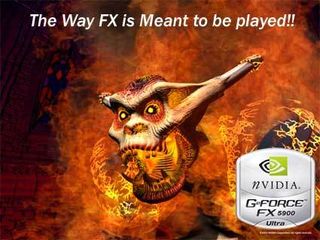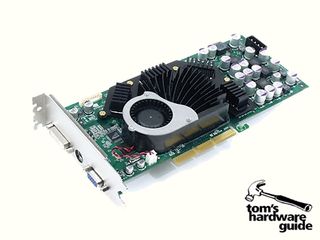NVIDIA GeForceFX 5900 Ultra: The Way FX is Meant to be Played!!
Introduction

As if anyone doubted that the graphics card market was fickle with a short attention span, it almost seems as though NVIDIA is going out of its way to prove the point. Just as graphics cards based on the GeForceFX 5800 chipset (a.k.a. NV30) are finally making their way into the retail channel, NVIDIA is introducing its follow-up product. Following the company's nomenclature, the new high-end chip will be called NVIDIA GeForceFX 5900 (NV35).
There are several compelling reasons behind this somewhat surprising step. The previous flagship, the FX 5800 Ultra, was plagued by several problems. Due to the high clockspeed of 500 MHz and the new 0.13 micron process, the yields for this chip were much lower than expected. The DDR-II memory it requires is expensive, not yet available in sufficient quantities and only supports a 128 bit bus, creating a memory bottleneck. On top of that, NVIDIA's reference cooling solution proved to be unacceptably loud, earning the reference card the nickname "dustbuster." Lastly, the chip's image quality when using anisotropic filtering also didn't live up to expectations and was criticized in many reviews. When ATi launched its Radeon 9800 PRO, it was able to beat NVIDIA's flagship in practically every discipline. In short, the FX 5800/ NV30 is too loud, too expensive, offers sub-par image quality and is slower than its direct competitor, the Radeon 9800.

The GeForceFX 5900 Ultra looks completely different from its predecessor.
NVIDIA is aiming to remedy the situation with the new FX 5900 (NV35) series. Obviously, this is not a completely new design, but a lot of details have been changed and improved. For example, the memory bus has been widened from 128 to 256 bits, and the design no longer calls for DDR-II memory but uses conventional DDR modules instead. The chip's core speed has been reduced from 500 MHz to 450 MHz to increase production yield. Many gamers and definitely all hardware testers will be relieved to know that the new cooling solution sounds a lot less like a vacuum cleaner and operates at a much more bearable volume. And lastly, a new driver is supposed to give the FX series a performance boost and improve image quality with FSAA and anisotropic filtering. There are a few other optimizations as well, which should help to counterbalance the reduction in clock speed. A new memory interface (IntelliSample HCT) improves the efficiency of 4:1 color compression by 50 percent, which should benefit FSAA performance. The CineFX Engine, now at version 2.0, has also been extended and offers a new technology called "UltraShadow." Games that have been adapted to use this feature and use stencil calculations for shadows should see a tangible increase in rendering speed. To accommodate these additions and improvements, the chip itself had to grow and now consists of about 130 million transistors, a good 5 million more than the NV30.

The GeForceFX 5900 Ultra GPU.
Stay on the Cutting Edge
Join the experts who read Tom's Hardware for the inside track on enthusiast PC tech news — and have for over 25 years. We'll send breaking news and in-depth reviews of CPUs, GPUs, AI, maker hardware and more straight to your inbox.
Most Popular

